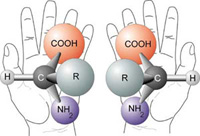Searching for signs of life on Mars
If life ever arose on the Red Planet, it probably did when Mars was warmer and wetter, sometime within the first billion years following planetary formation. Conditions then were similar to those when microbes gained a foothold on the young Earth. This marks Mars as a primary target for the search for signs of life in our Solar System.
Extinct life
On Earth, high-temperature metamorphic processes and plate tectonics have resulted in the reformation of most ancient terrains. It is very difficult to find rocks on Earth older than 3 billion years in good condition. Hence, the physico-chemical record of the very early evolution of life on Earth is no longer accessible to us.
In the study of ancient biomarkers there are two major difficulties: the first one is that some inorganic processes can produce mineral structures very similar to simple biological shapes, making it difficult to establish the origins of ancient microfossils just on the basis of their morphology; the second one is that many biomarkers decompose when exposed to temperatures greater than 200°C, that is the case of most ancient terrestrial rocks.
Mars has not been affected by widespread tectonic activity; consequently it may be possible to find ancient rocks that have not been exposed to high-temperatures.
The best chance to find signatures of ancient life on Mars is in the form of chemical biomarkers and fossil communities, either preserved underground or within surface rocks.
Since liquid water is a prerequisite for life, good candidate locations to look for microfossils are terrains occupied by long-lasting bodies of water during Mars’ early history.
ESA’s ExoMars Rover will use multiple strategies to search for life, including investigations to characterise potential habitats, visual examination of outcrops (morphology), and spectrochemical composition analyses performed on well-selected samples.
Homochirality and life
 |
| Many of life's most important molecules can exist in left- or right-handed configurations |
Two of life's most important molecular building blocks —amino acids and sugars— can exist in left- and right-handed configurations called enantiomers* which, like a pair of gloves, are mirror images of one another. (* Enantiomer: From the Greek enantios, denoting 'opposite' or 'opposing'.)
On Earth all living organisms use one enantiomer only: left-handed in the case of amino acids and right-handed for sugars. This property of homochirality** is essential for an efficient metabolism. Key life processes, such as protein synthesis and gene transcription, rely on amino acids and sugars having the correct spatial structure to 'shake hands' at molecular level with their counterparts.
(** Homochirality: Compound word derived from Greek, meaning 'same handedness'.)
Conversely, synthetic chemicals prepared in the laboratory exhibit equal abundances of both right- and left-handed enantiomers —such a mixture is said to be racemic. Homochirality probably constitutes the most reliable indicator of the biological versus abiotic origin of organic molecules. As a consequence, testing for homochirality becomes crucial when searching for life. However, as in the previous methods outlined, this one also suffers when the sample is exposed to high temperatures or wet conditions for extended periods.
Extant life
Looking for evidence of extant life was one of the objectives of the Viking biology experiments in 1976. The twin landers conducted the first in-situ measurements focusing on the detection of organic compounds and life on Mars.
The Viking biology package contained three experiments, all looking for signs of metabolism in soil samples. One of them, the Labelled-Release Experiment, produced very provocative results that could have been interpreted as proof of biological activity.
Numerous attempts have been made in the laboratory to simulate the reactions observed by the Viking biological package. While some have reproduced certain aspects of the data, none has succeeded entirely. Incredibly, almost 30 years after Viking, the crucial chemical oxidant hypothesis remains untested. However, most scientists now believe that the results can be explained by chemical processes and they do not demonstrate the presence of life on Mars.
The ExoMars Rover will therefore include a powerful instrument to study organics and their relation to the distribution of oxidants on Mars.
